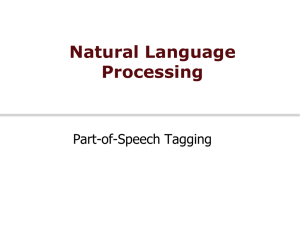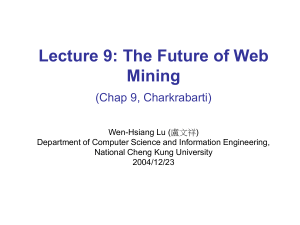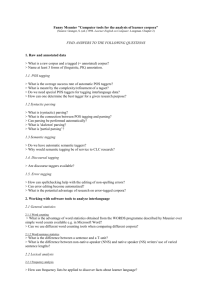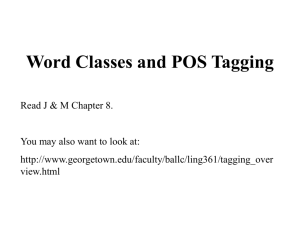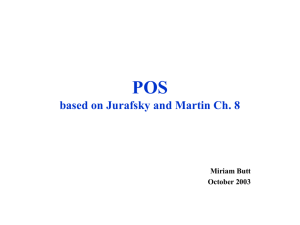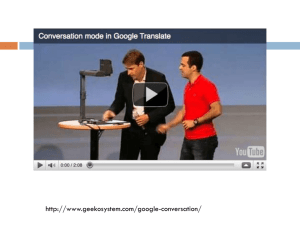Capturing Long-distance Dependencies in Sequence Models:
advertisement
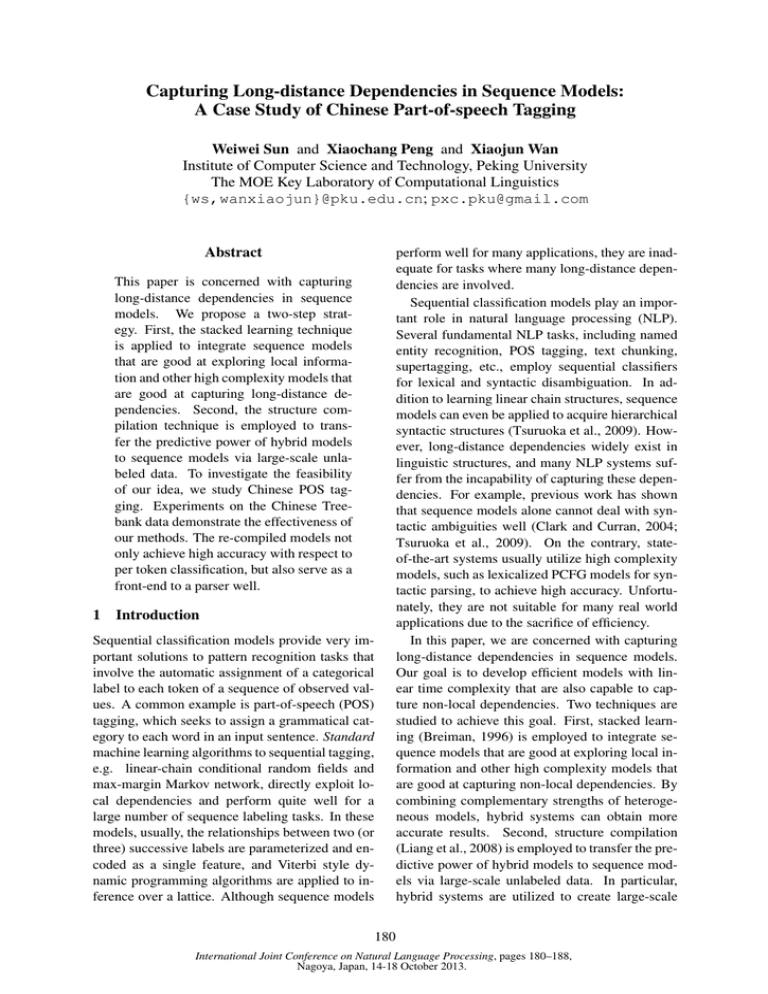
Capturing Long-distance Dependencies in Sequence Models:
A Case Study of Chinese Part-of-speech Tagging
Weiwei Sun and Xiaochang Peng and Xiaojun Wan
Institute of Computer Science and Technology, Peking University
The MOE Key Laboratory of Computational Linguistics
{ws,wanxiaojun}@pku.edu.cn; pxc.pku@gmail.com
Abstract
perform well for many applications, they are inadequate for tasks where many long-distance dependencies are involved.
Sequential classification models play an important role in natural language processing (NLP).
Several fundamental NLP tasks, including named
entity recognition, POS tagging, text chunking,
supertagging, etc., employ sequential classifiers
for lexical and syntactic disambiguation. In addition to learning linear chain structures, sequence
models can even be applied to acquire hierarchical
syntactic structures (Tsuruoka et al., 2009). However, long-distance dependencies widely exist in
linguistic structures, and many NLP systems suffer from the incapability of capturing these dependencies. For example, previous work has shown
that sequence models alone cannot deal with syntactic ambiguities well (Clark and Curran, 2004;
Tsuruoka et al., 2009). On the contrary, stateof-the-art systems usually utilize high complexity
models, such as lexicalized PCFG models for syntactic parsing, to achieve high accuracy. Unfortunately, they are not suitable for many real world
applications due to the sacrifice of efficiency.
In this paper, we are concerned with capturing
long-distance dependencies in sequence models.
Our goal is to develop efficient models with linear time complexity that are also capable to capture non-local dependencies. Two techniques are
studied to achieve this goal. First, stacked learning (Breiman, 1996) is employed to integrate sequence models that are good at exploring local information and other high complexity models that
are good at capturing non-local dependencies. By
combining complementary strengths of heterogeneous models, hybrid systems can obtain more
accurate results. Second, structure compilation
(Liang et al., 2008) is employed to transfer the predictive power of hybrid models to sequence models via large-scale unlabeled data. In particular,
hybrid systems are utilized to create large-scale
This paper is concerned with capturing
long-distance dependencies in sequence
models. We propose a two-step strategy. First, the stacked learning technique
is applied to integrate sequence models
that are good at exploring local information and other high complexity models that
are good at capturing long-distance dependencies. Second, the structure compilation technique is employed to transfer the predictive power of hybrid models
to sequence models via large-scale unlabeled data. To investigate the feasibility
of our idea, we study Chinese POS tagging. Experiments on the Chinese Treebank data demonstrate the effectiveness of
our methods. The re-compiled models not
only achieve high accuracy with respect to
per token classification, but also serve as a
front-end to a parser well.
1
Introduction
Sequential classification models provide very important solutions to pattern recognition tasks that
involve the automatic assignment of a categorical
label to each token of a sequence of observed values. A common example is part-of-speech (POS)
tagging, which seeks to assign a grammatical category to each word in an input sentence. Standard
machine learning algorithms to sequential tagging,
e.g. linear-chain conditional random fields and
max-margin Markov network, directly exploit local dependencies and perform quite well for a
large number of sequence labeling tasks. In these
models, usually, the relationships between two (or
three) successive labels are parameterized and encoded as a single feature, and Viterbi style dynamic programming algorithms are applied to inference over a lattice. Although sequence models
180
International Joint Conference on Natural Language Processing, pages 180–188,
Nagoya, Japan, 14-18 October 2013.
unlabeled data is effective to re-compile simple
models, including latent variable hidden Markov
models, local and global linear classifiers. On one
hand, the precison in terms of word classification
is improved to 95.33%, which reachs the state-ofthe-art. On the other hand, re-compiled models
are adapted based on parsing results, and as a result the ability to capture syntagmatic lexical relations is improved as well. Different from the
purely supervised sequence models, re-compiled
models also serve as a front-end to a parser well.
pseudo training data for cheap sequence models.
A discriminative model can be improved by incorporating more features, while a generative latent variable model can be improved by increasing
the number of latent variables. By using stacking
and structure compilation techniques, a sequence
model can be enhanced to better capture longdistance dependencies and to achieve more accurate results.
To demonstrate the feasibility to capture longdistance dependencies in a sequence model, we
present our work on Chinese POS tagging. The
Chinese language has a number of characteristics
that make Chinese POS tagging particularly challenging. While simple sequential classifiers can
easily achieve tagging accuracies of above 97%
on English, Chinese POS tagging has proven to
be more challenging and has obtained accuracies
of about 93-94% (Huang et al., 2009; Sun and
Uszkoreit, 2012) when applying sequence models. Recent work shows that higher accuracy (c.a.
95%) can be achieved by applying advanced learning techniques to capture deep lexical relations
(Sun and Uszkoreit, 2012). Especially, syntagmatic lexical relations have been shown playing an
essential role in Chinese POS tagging. To capture
such relations, an accurate POS tagging model
should know more information about long range
dependencies. Previous work has used syntactic
parsers in either constituency or dependency formalisms to exploit such useful information (Sun
and Uszkoreit, 2012; Hatori et al., 2011). However, it is inapproporiate to employ computationally expensive parsers to improve POS tagging for
many realistic NLP applications, mainly due to efficiency considerations.
2
Background
The Chinese language has a number of characteristics that make Chinese POS tagging particularly
challenging. For example, Chinese is characterized by the lack of formal devices such as morphological tense and number that often provide important clues for syntactic processing. Chinese POS
tagging has proven to be very difficult and has obtained accuracies of about 93-94% (Huang et al.,
2009; Li et al., 2011; Hatori et al., 2011; Sun and
Uszkoreit, 2012). On the other hand, Chinese POS
information is very important for advanced NLP
tasks, e.g. supertagging, full parsing and semantic role labeling. Previous work has repeatedly
demonstrated the significant performance gap of
NLP systems while using gold standard and automatically predicted POS tags (Zhang and Clark,
2009; Li et al., 2011; Tse and Curran, 2012). In
this section, we give a brief introduction and a
comparative analysis to several models that are recently designed to resolve the Chinese POS tagging problem.
2.1
In this paper, we study several hybrid systems
that are built upon various complementary tagging
systems. We investigate stacked learning to build
more accurate solutions by integrating heterogeneous models. Experiments on the Chinese Treebank (CTB) data show that stacking is very effective to build high-accuracy tagging systems. Although predictive powers of hybrid systems are
significantly better than individual systems, they
are not suitable for large-scale real word applications that have stringent time requirements. To improve POS tagging efficiency without loss of accuracy, we explore unlabeled data to transfer the
predictive power of complex, inefficient models to
simple, efficient models. Experiments show that
Various Chinese POS Tagging Models
Local linear model (LLM) A very simple approach to POS tagging is to formulate it as a local
word classification problem. Various features can
be drawn upon information sources such as word
forms and characters that constitute words. Previous studies on many languages have shown that
local classification is inadequate to capture structural information of output labels, and thus does
not perform as well as structured models.
Linear-chain global linear model (LGLM)
Sequence labeling models can capture output
structures by exploiting local dependencies among
words. A global linear model is flexible to in181
provements over the pipeline systems in both POS
tagging and dependency parsing tasks.
clude linguistic knowledge from multiple information sources, and thus suitable to recognize more
new words. A majority of state-of-the-art English
POS taggers are based on LGLMs, e.g. structured perceptron (Collins, 2002) and conditional
random fields (Lafferty et al., 2001). Such models are also very popular for building Chinese POS
taggers (Sun and Uszkoreit, 2012).
2.2
Comparison
We can distinguish the five representative tagging
models from two views (see Table 2). From a linguistic view, we can distinguish syntax-free and
syntax-based models. In a syntex-based model,
POS tagging is integrated into parsing, and thus
(to some extent) is capable of capturing long range
syntactic information. From a machine learning
view, we can distinguish generative and discriminative models. Compared to generative models,
discriminative models define expressive features
to classify words. Note that the two generative
models employ latent variables to refine the output spaces, which significantly boost the accuracy
and increase the robustness of simple generative
models.
Hidden Markov model with latent variables
(HMMLA) Generative models with latent annotations (LA) obtain state-of-the-art performance
for a number of NLP tasks. For example,
both PCFG and TSG with refined latent variables achieve excellent results for syntactic parsing (Matsuzaki et al., 2005; Shindo et al., 2012).
For Chinese POS tagging, Huang, Eidelman and
Harper (2009) described and evaluated a bi-gram
HMM tagger that utilizes latent annotations. The
use of latent annotations substantially improves
the performance of a simple generative bigram
tagger, outperforming a trigram HMM tagger with
sophisticated smoothing.
Syntax-free
Syntax-based
PCFG Parsing with latent variables (PCFGLA)
POS tags can be taken as preterminals of a constituency parse tree, so a constituency parser can
also provide POS information. The majority of
the state-of-the-art constituent parsers are based
on generative PCFG learning, with lexicalized
(Collins, 2003; Charniak, 2000) or latent annotation (Matsuzaki et al., 2005; Petrov et al., 2006)
refinements. Compared to complex lexicalized
parsers, the PCFGLA parsers leverage on an automatic procedure to learn refined grammars and
are more robust to parse many non-English languages that are not well studied. For Chinese, a
PCFGLA parser achieves the state-of-the-art performance and outperforms many other types of
parsers (Zhang and Clark, 2009).
Generative
HMMLA
PCFGLA
Discriminative
LLM, LGLM
DEP
Table 2: Two views of different tagging models.
2.3
Evaluation
2.3.1 Experimental Setting
Penn Chinese Treebank (CTB) (Xue et al., 2005)
is a popular data set to evaluate a number of
Chinese NLP tasks, including word segmentation, POS tagging, syntactic parsing in both constituency and dependency formalisms. In this paper, we use CTB 6.0 as the labeled training data for
the study. In order to obtain a representative split
of data sets, we conduct experiments following the
setting of the CoNLL 2009 shared task (Hajič et
al., 2009), which is also used by (Sun and Uszkoreit, 2012). The setting is provided by the principal
organizer of the CTB project, and has considered
many annotation details. This setting is very robust for evaluating Chinese language processing
algorithms.
We present an empirical study of the five typical approaches introduced above. In our experiments, to build local and global word classifiers
(i.e. LLMs and LGLMs), we implement the feature set used in (Sun and Uszkoreit, 2012). Denote a word w in focus with a fixed window
w−2 w−1 ww+1 w+2 . The features include:
2.1.1
Joint POS Tagging and Dependency
Parsing (DEP)
(Hatori et al., 2011) proposes an incremental processing model for the task of joint POS tagging
and dependency parsing, which is built upon a
shift-reduce parsing framework with dynamic programming. Given a segmented sentence, a joint
model simultaneously considers possible POS tags
and dependency relations. In this way, the learner
can better predict POS tags by using bi-lexical dependency information. Their experiments show
that the joint approach achieved substantial im-
• Word unigrams: w−2 , w−1 , w, w+1 , w+2 ;
182
Devel.
Overall
NR
NT
NN
DEC
DEG
UNK
LLM
93.96%
95.07
97.61
94.89
78.61
82.44
--
LGLM(SP)
94.30%/94.49%
94.47/94.85
97.22/97.75
94.67/94.79
81.98/82.36
85.58/86.72
80.0%/81.1%
LGLM(PA)
94.24%/94.33%
94.41/94.56
97.66/97.59
94.72/94.71
80.68/81.76
85.37/85.00
--
HMMLA
94.16%
94.22
97.18
94.30
80.60
85.19
78.2%
PCFGLA
93.69%
89.84
96.70
93.56
85.78
88.94
--
DEP
94.58%
93.55
96.84
94.55
86.73
89.45
--
Table 1: Tagging accuracies of different supervised models on the development data.
• Word bigrams: w−2 w−1 , w−1 w, w w+1 ,
w+1 w+2 ;
good enough to deal with nouns. Surprisingly, the
local classifier that does not directly define features of possible POS tags of other surrounding
words performs even better than structured models for proper nouns and other common nouns.
The tag DEC denotes a complementizer or a
nominalizer, while the tag DEG denotes a genitive
marker and an associative marker. These two types
only include two words: “的” and “之.” The latter one is mainly used in ancient Chinese. 5.19%
of words appearing in the training data set is
DEC/DEG. The pattern of the DEC recognition is
clause/verb phrase+DEC+noun phrase, and The
pattern of the DEG recognition is nominal modifier+DEC+noun phrase. To distinguish the sentential/verbal and nominal modification phrases,
the DEC and DEG words usually need long range
syntactic information for accurate disambiguation.
We claim that the prediction performance of the
two specific types is a good clue of how well a tagging model resolves long distance dependencies.
We can see that the two syntactic parsers significantly outperform local models on the prediction
of these types of words.
The weak ability for non-local disambiguation
also imposes restrictions on using a sequence POS
tagging model as front module for parsing. To
evaluate the impact, we employ the PCFGLA
parser to parse a sentence based on the POS tags
provided by sequence models. Table 4 shows the
parsing performance. Note that the overall tagging performance of the Berkeley parser is significantly worse than sequence models. However,
better POS tagging does not lead to better parsing. The experiments suggest that sequence models propagate too many errors to the parser. Our
linguistic analysis can also well explain the poor
performance of Chinese CCG parsing when applying the C&C parser (Tse and Curran, 2012). We
think the failure is mainly due to overplaying sequence models in both POS tagging and supertag-
• Character n-gram prefixes and suffixes for n
up to 3.
To train LLMs, we use the open source linear classifier – LIBLINEAR1 . To train LGLMs, we choose
structured perceptron (SP) (Collins, 2002) and
passive aggressive (PA) (Crammer et al., 2006)
learning algorithms. For the LAHMM and DEP
models, we use the systems discribed in (Huang
et al., 2009; Hatori et al., 2011); for the PCFGLA
models, we use the Berkeley parser2 .
2.3.2 Results
Table 1 summarizes the performance in terms
of per word classification of different supervised
models on the development data. We present the
results of both first order (on the left) and second
order (on the right) LGLMs. We can see that the
perceptron algorithm performs a little better than
the PA algorithm for Chinese POS tagging. There
is only a slight gap between the local classification
model and various structured models. This is very
different from English POS tagging. Although the
local classifier achieves comparable results when
respectively applied to English and Chinese, there
is much more significant gap between the corresponding structured models. Similarly, the gap between the first and second order LGLMs is very
modest too.
From the linguistic view, we mainly consider
the disambiguiation ability of local and non-local
dependencies. Table 1 presents accuracy results
of several POS types, including nouns and functional words. The POS types NR, NT and NN respectively represent proper nouns, temporal nouns
and other common nouns. We can clearly see that
models which only explore local dependencies are
1
2
www.csie.ntu.edu.tw/˜cjlin/liblinear/
code.google.com/p/berkeleyparser/
183
LLM
Baseline
+Word clustering
+Word clustering+HMMLA
+Word clustering+PCFGLA
+Word clustering+DEP
+ALL
93.96%
94.75%
95.12%
95.42%
95.28%
95.56%
First order LGLM
SP
PA
94.30% 94.24%
94.90% 94.80%
95.19% 95.18%
95.50% 95.40%
95.22% 95.26%
95.61% 95.60%
Second order LGLM
SP
PA
94.49%
94.33%
95.05%
94.96%
95.14% 95.22%
95.56%
95.44%
95.29%
95.25%
95.53%
95.53%
Table 3: Tagging accuracies of different stacking models on the development data.
fine features for the LLM/LGLM.
ging.
Devel.
Berkeley
1or LGLM
2or LGLM
HMMLA
1or LGLM(HMMLA)
1or LGLM(PCFGLA)
1or LGLM(DEP)
LP
80.44
80.38
80.98
80.65
81.55
82.84
82.69
LR
80.31
79.48
79.93
79.62
80.80
81.75
81.68
3.1
F1
81.36
79.93↓
80.45↓
80.13↓
81.17↓
82.29↑
82.18↑
Stacked generalization is a meta-learning algorithm that has been first proposed in (Wolpert,
1992) and (Breiman, 1996). Stacked learning has
been applied as a system ensemble method in several NLP tasks, such as joint word segmentation
and POS tagging (Sun, 2011), and dependency
parsing (Nivre and McDonald, 2008). The idea
is to include two “levels” of predictors. The first
level includes one or more predictors g1 , ..., gK :
Rd → R; each receives input x ∈ Rd and outputs a prediction gk (x). The second level consists
of a single function h : Rd+K → R that takes
as input hx, g1 (x), ..., gK (x)i and outputs a final
prediction ŷ = h(x, g1 (x), ..., gK (x)). The predictor, then, combines an ensemble (the gk ’s) with
a meta-predictor (h).
Table 4: Parsing accuracies on the development
data. 1or and 2or respectively denote first order
and second order. LGLM(X) denotes a stacking
model with X as the level-0 processing. All stacking models incorporate word clusters to improve
the tagging accuracy.
To distinguish the predictive abilities of generative and discriminative models, we report the precison of the prediction of unknown words (UNK).
Discriminative learning can define arbitrary (even
overlapping) features which play a central role in
tagging English unknown words. The difference
between generative and discriminative learning in
Chinese POS tagging is not that much, mainly
because most Chinese words are compactly composed by a very few Chinese characters that are
usually morphemes. This language-specific property makes it relatively easy to smooth parameters
of a generative model.
3
Stacked Learning
3.2
Applying Stacking to POS Tagging
We use the LLMs or LGLMs (as h) for the level-1
processing, and other models (as gk ) for the level0 processing. The characteristic of discriminative learning makes LLMs/LGLMs very easy to
integrate the outputs of other models as new features. We are relying on the ability of discriminative learning to explore informative features,
which play a central role in boosting the tagging
accuracy. For output labels produced by each auxiliary model, five new label uni/bi-gram features
are added: w−1 , w, w+1 , w−1 w, w w+1 . This
choice is tuned on the development data.
Word clusters that are automatically acquired
from large-scale unlabeled data have been shown
to be very effective to bridge the gap between high
and low frequency words, and therefore significantly improve tagging, as well as other syntactic
processing tasks. Our stacking models are all built
on word clustering enhanced discriminative linear
models. Five word cluster uni/bi-gram features are
Improving Tagging Accuracy via
Stacking
In this section, we study a simple way of integrating multiple heterogeneous models in order to
exploit their complementary strength and thereby
improve tagging accuracy beyond what is possible by either model in isolation. The method integrates the heterogeneous models by allowing the
outputs of the HMMLA, PCFGLA and DEP to de184
added: w−1 , w, w+1 , w−1 w, w w+1 . The clusters are acquired based on the Chinese giga-word
data with the MKCLS tool. The number of total
clusters is set to 500, which is tuned by (Sun and
Uszkoreit, 2012).
3.3
that it uses parser multiple times. We also implement their method and compare the results with
our stacking model. We find the accuracy performance produced by the two different methods are
comparable.
(Rush et al., 2010) introduced dual decomposition as a framework for deriving inference algorithms for serious combinatorial problems in NLP.
They successfully applied dual decomposition to
the combination of a lexicalized parsing model
and a trigram POS tagger. Despite the effectiveness, their method iteratively parses a sentence
many times to achieve convergence, and thus is
not as efficient as stacking.
Evaluation
Table 3 summarizes the tagging accuracy of different stacking models. From this table, we can
clearly see that the new features derived from the
outputs of other models lead to substantial improvements over the baseline LLM/LGLM. The
output structures provided by the PCFGLA model
are most effective in improving the LLM/LGLM
baseline systems. Among different stacking models, the syntax-free hybrid one (i.e., stacking
LLM/LGLM with HMMLA) does not need any
treebank to train their systems. For the situations that parsers are not available, this is a good
solution. Moreover, the decoding algorithms for
linear-chain Markov models are very fast. Therefore the syntax-free hybrid system is more appealing for many NLP applications.
Table 5 is the F1 scores of the DEC/DEG prediction which are obtained by different stacking
models. Compared to Table 1, we can see that the
hybrid sequence model is still not good at handling
long-distance ambiguities. As a result, it harms
the parsing performance (see Table 4), though it
achieves higher overall precison.
Devel.
1or LGLM(HMMLA)
1or LGLM(PCFGLA)
1or LGLM(DEP)
DEC
82.93
88.11
87.46
4
4.1
The Idea
Hybrid structured models often achieve excellent
performance but can be slow at test time. In our
problem, it is obviously too inefficient to improve
POS tagging by parsing a sentence first. In this
section, we explore unlabeled data to transfer the
predictive power of hybrid models to sequence
models. The main idea behind this is to use a
fast model to approximate the function learned by
a slower, larger, but better performing ensemble
model. Unlike the true function that is unknown,
the function learned by a high performing model is
available and can be used to label large amounts of
pseudo data. A fast and expressive model trained
on large scale pseudo data will not overfit and will
approximate the function learned by the high performing model well. This allows a slow, complex
model such as massive ensemble to be compressed
into a fast sequence model such as a first order
LGLM with very little loss in performance.
This idea to use unlabeled data to transfer the
predictive power of one model to another has been
investigated in many areas, for example, from high
accuracy neural networks to more interpretable decision trees (Craven, 1996), from high accuracy
ensembles to faster and more compact neural networks (Bucila et al., 2006), or from structured
prediction models to local classification models
(Liang et al., 2008),
DEG
86.64
91.12
89.86
Table 5: F1 score of the DEC/DEG prediction
of different stacking models on the development
data.
3.4
Improving Tagging Efficiency through
Unlabeled Data
Related Work
(Sun and Uszkoreit, 2012) introduced a Bagging
model to effectively combine the outputs of individual systems. In the training phase, given a
training set D of size n, the Bagging model generates m new training sets Di ’s by sampling examples from D. Each Di is separately used to train
k individual models. In the tagging phase, the km
models outputs km tagging results, each word is
assigned one POS label. The final tagging is the
voting result of these km labels. Although this
model is effective, it is too expensive in the sense
4.2
Reducing Hybrid Models to Sequence
Models
For English POS tagging, Liang, Daumé and
Klein (2008) have done some experiments to
185
Size of data
+100k
+200k
+500k
+1000k
HMMLA
94.72%
94.77%
94.97%
95.09%
LLM
LGLM
win size=3
95.05% 95.07%
95.06% 95.18%
95.11% 95.21%
95.19% 95.23%
LLM
LGLM
win size=4
95.04% 95.10%
95.20% 95.23%
95.15% 95.23%
95.22% 95.31%
Voting
DEC/DEG
95.36%
-95.43%
-95.43%
-95.49% 85.75/89.01
Table 6: Tagging accuracies of different re-compiled models on the development data.
prove a purely supervised HMMLA. In our experiments, all HMMLA models are trained with 8 iterations of split, merge, smooth. The second column
of Table 6 shows the performance of the re-trained
HMMLAs. The first column is the number of sentences of pseudo sentences. The pseudo sentences
are selected from the begining of the Chinese gigaword. We can clearly see that the idea to leverage unlabeled data to transfer the predictive ability
of the hybrid model works. Self-training can also
slightly improve a HMMLA (Huang et al., 2009).
Our auxiliary experiments show that self-training
is not as effective as our methods.
transfer the power of a chain conditional random field to a logistic regression model. Similarly, we do some experiments to explore the feasibility of reducing hybrid tagging models to a
HMMLA, LLM or LGLM, for Chinese POS tagging. The large-scale unlabeled data we use in our
experiments comes from the Chinese Gigaword
(LDC2005T14), which is a comprehensive archive
of newswire text data that has been acquired over
several years by the Linguistic Data Consortium
(LDC). We choose the Mandarin news text, i.e.
Xinhua newswire. We tag giga-word sentences
by applying the stacked first order LGLMs with
all other models. In other words, the HMMLA,
PCFGLA and DEP systems are applied to tag unlabeled data features and their outputs are utilized
to define features for first-order and second-order
LGLMs which produce pseudo training data. Both
original gold standard training data and pseudo
training data are used to re-train a HMMLA, a
LLM/LGLM with extended features.
The key for the success of hybrid tagging models is the existence of a large diversity among
learners. Zhou (2009) argued that when there are
lots of labeled training examples, unlabeled instances are still helpful for hybrid models since
they can help to increase the diversity among the
base learners. The author also briefly introduced
a preliminary theoretical study. In this paper, we
also combine the re-trained models to see if we
can benefit more. We utilize voting as the strategy
for final combination. In the tagging phase, the retrained LLM, LGLM and HMMLA systems outputs 3 tagging results, each word is assigned one
POS label. The final tagging is the voting result of
these 3 labels.
4.3
4.3.1
4.3.2
Reducing Hybrid Models to
LLM/LGLM
To increase the expressive power of a discriminative classification model, we extend the feature
templates. This strategy is proposed by (Liang et
al., 2008). In our experiments, we increase the
window size of word uni/bi-gram features to approximate long distance dependencies. For window size 3, we will add w−3 , w3 , w−3 w−2 and
w2 w3 as new features; for size 4, we will add
w−4 , w−3 , w3 , w4 , w−4 w−3 , w−3 w−2 , w2 w3 and
w3 w4 ; Column 3 to 6 of Table 6 show the performance of the re-compiled LLMs/LGLMs. Similar to the generative model, the discriminative
LLM/LGLM can be improved too.
4.3.3
Voting
The last two columns of Table 6 are the final voting results of the HMMLA, LLM and LGLM. The
window size of word uni/bi-gram features for the
LLM and LGLM is set to 4. Obviously, the retrained models are still diverse and complementary, so the voting can further improve the sequence models. The result of the best hybrid
sequence model is very close to the best stacking models. Furthermore, the F1 scores of the
DEC/DEG prediction are 85.75 and 89.01, which
are very close to parsers too.
Experiments
Reducing Hybrid Models to HMMLA
With the increase of (pseudo) training data, a
HMMLA may learn better latent variables to subcategorize POS tags, which could significantly im186
4.3.4 Improving Parsing
Purely supervised sequence models are not good
at predicting function words, and accordingly are
not good enough to be used as front modules to
parsers. The re-compiled models can mimic some
behaviors of parsers, and therefore are suitable for
parsing. Our evaluation shows that the significant improvement of the POS tagging stop harming syntactic parsing. Results in Table 7 indicate
that the parsing accuracy of the Berkeley parser
can be simply improved by inputting the Berkeley parser with the re-trained sequential tagging
results. Additionally, the success to separate tagging and parsing can improve the whole syntactic
processing efficiency.
Devel.
HMMLA
LLM
LGLM
Voting
LP
82.18
81.86
82.07
82.34
LR
81.16
80.93
81.21
81.42
machine learning techniques, we are able to build
good sequential POS taggers. Another advantage
of our system is that it serves as a front-end to a
parser very well. Our study suggests that complicated structured models can be well simulated by
simple sequence models through unlabeled data.
Acknowledgement
The work was supported by NSFC (61170166),
Beijing Nova Program (2008B03) and National
High-Tech R&D Program (2012AA011101).
References
Leo Breiman. 1996. Stacked regressions. Machine
Learning, 24:49–64, July.
F1
81.66↑
81.40↑
81.64↑
81.88↑
Cristian Bucila, Rich Caruana, and Alexandru
Niculescu-Mizil. 2006. Model compression. In
KDD, pages 535–541.
Eugene Charniak.
2000.
A maximum-entropyinspired parser. In Proceedings of NAACL.
Table 7: Accuracies of parsing based on recompiled tagging.
Stephen Clark and James R. Curran. 2004. The importance of supertagging for wide-coverage ccg parsing. In Proceedings of Coling 2004, pages 282–288,
Geneva, Switzerland, Aug 23–Aug 27. COLING.
4.3.5 Final results
Table 8 shows the performance of different systems evaluated on the test data. Our final sequence model achieve the state-of-the-art performance, which is once obtained by combining multiple parsers as well as sequence models.
Systems
(Sun and Uszkoreit, 2012)
Our system
Michael Collins. 2002. Discriminative training methods for hidden markov models: Theory and experiments with perceptron algorithms. In Proceedings
of EMNLP, pages 1–8. Association for Computational Linguistics, July.
Michael Collins. 2003. Head-driven statistical models
for natural language parsing. Computational Linguistics, 29(4):589–637.
Acc.
95.34%
95.33%
Koby Crammer, Ofer Dekel, Joseph Keshet, Shai
Shalev-Shwartz, and Yoram Singer. 2006. Online
passive-aggressive algorithms. JOURNAL OF MACHINE LEARNING RESEARCH, 7:551–585.
Table 8: Tagging accuracies on the test data.
5
Conclusion
Mark Craven. 1996. Extracting Comprehensible Models from Trained Neural Networks. Ph.D. thesis,
University of Wisconsin-Madison, Department of
Computer Sciences. Also appears as UW Technical
Report CS-TR-96-1326.
In this paper, we study two techniques to build
accurate and fast sequence models for Chinese
POS tagging. In particular, our goal is to capture
long-distance dependencies in sequence models.
To improve tagging accuracy, we study stacking
to integrate multiple models with heterogeneous
views. To improve tagging efficiency at test time,
we explore unlabeled data to transfer the predictive power of hybrid models to simple sequence
or even local classification models. Hybrid systems are utilized to create large-scale pseudo training data for cheap models. By applying complex
Jan Hajič, Massimiliano Ciaramita, Richard Johansson, Daisuke Kawahara, Maria Antònia Martı́, Lluı́s
Màrquez, Adam Meyers, Joakim Nivre, Sebastian
Padó, Jan Štěpánek, Pavel Straňák, Mihai Surdeanu,
Nianwen Xue, and Yi Zhang. 2009. The CoNLL2009 shared task: Syntactic and semantic dependencies in multiple languages. In Proceedings of
the 13th Conference on Computational Natural Language Learning (CoNLL-2009), June 4-5, Boulder,
Colorado, USA.
187
pages 1–11, Cambridge, MA, October. Association
for Computational Linguistics.
Jun Hatori, Takuya Matsuzaki, Yusuke Miyao, and
Jun’ichi Tsujii. 2011. Incremental joint POS tagging and dependency parsing in chinese. In Proceedings of 5th International Joint Conference on
Natural Language Processing, pages 1216–1224,
Chiang Mai, Thailand, November. Asian Federation
of Natural Language Processing.
Hiroyuki Shindo, Yusuke Miyao, Akinori Fujino, and
Masaaki Nagata. 2012. Bayesian symbol-refined
tree substitution grammars for syntactic parsing. In
Proceedings of ACL, pages 440–448, Jeju Island,
Korea, July. Association for Computational Linguistics.
Zhongqiang Huang, Vladimir Eidelman, and Mary
Harper. 2009. Improving a simple bigram hmm
part-of-speech tagger by latent annotation and selftraining. In Proceedings of Human Language Technologies: The 2009 Annual Conference of the North
American Chapter of the Association for Computational Linguistics, Companion Volume: Short Papers, pages 213–216, Boulder, Colorado, June. Association for Computational Linguistics.
Weiwei Sun and Hans Uszkoreit. 2012. Capturing
paradigmatic and syntagmatic lexical relations: Towards accurate Chinese part-of-speech tagging. In
Proceedings of the 50th Annual Meeting of the Association for Computational Linguistics. Association
for Computational Linguistics, July.
Weiwei Sun. 2011. A stacked sub-word model for
joint Chinese word segmentation and part-of-speech
tagging. In Proceedings of the 49th Annual Meeting of the Association for Computational Linguistics: Human Language Technologies, pages 1385–
1394, Portland, Oregon, USA, June. Association for
Computational Linguistics.
John D. Lafferty, Andrew McCallum, and Fernando
C. N. Pereira. 2001. Conditional random fields:
Probabilistic models for segmenting and labeling sequence data. In Proceedings of the Eighteenth International Conference on Machine Learning, ICML
’01, pages 282–289, San Francisco, CA, USA. Morgan Kaufmann Publishers Inc.
Daniel Tse and James R. Curran. 2012. The challenges of parsing chinese with combinatory categorial grammar. In Proceedings of the 2012 Conference of the North American Chapter of the Association for Computational Linguistics: Human
Language Technologies, pages 295–304, Montréal,
Canada, June. Association for Computational Linguistics.
Zhenghua Li, Min Zhang, Wanxiang Che, Ting Liu,
Wenliang Chen, and Haizhou Li. 2011. Joint models for Chinese POS tagging and dependency parsing. In Proceedings of the 2011 Conference on Empirical Methods in Natural Language Processing,
pages 1180–1191, Edinburgh, Scotland, UK., July.
Association for Computational Linguistics.
Percy Liang, Hal Daumé, III, and Dan Klein. 2008.
Structure compilation: trading structure for features.
In Proceedings of the 25th international conference
on Machine learning, ICML ’08, pages 592–599,
New York, NY, USA. ACM.
Yoshimasa Tsuruoka, Jun’ichi Tsujii, and Sophia Ananiadou. 2009. Fast full parsing by linear-chain
conditional random fields. In Proceedings of the
12th Conference of the European Chapter of the
ACL (EACL 2009), pages 790–798, Athens, Greece,
March. Association for Computational Linguistics.
Takuya Matsuzaki, Yusuke Miyao, and Jun’ichi Tsujii. 2005. Probabilistic cfg with latent annotations. In Proceedings of ACL, ACL ’05, pages 75–
82, Stroudsburg, PA, USA. Association for Computational Linguistics.
David H. Wolpert. 1992. Original contribution:
Stacked generalization. Neural Netw., 5:241–259,
February.
Nianwen Xue, Fei Xia, Fu-Dong Chiou, and Martha
Palmer. 2005. The penn Chinese treebank: Phrase
structure annotation of a large corpus. Natural Language Engineering, 11(2):207–238.
Joakim Nivre and Ryan McDonald. 2008. Integrating graph-based and transition-based dependency
parsers. In Proceedings of ACL-08: HLT, pages
950–958, Columbus, Ohio, June. Association for
Computational Linguistics.
Yue Zhang and Stephen Clark. 2009. Transitionbased parsing of the Chinese treebank using a global
discriminative model. In Proceedings of the 11th
International Conference on Parsing Technologies
(IWPT’09), pages 162–171, Paris, France, October.
Association for Computational Linguistics.
Slav Petrov, Leon Barrett, Romain Thibaux, and Dan
Klein. 2006. Learning accurate, compact, and
interpretable tree annotation. In Proceedings of
the 21st International Conference on Computational
Linguistics and 44th Annual Meeting of the Association for Computational Linguistics, pages 433–440,
Sydney, Australia, July. Association for Computational Linguistics.
Zhi-Hua Zhou. 2009. When semi-supervised learning
meets ensemble learning. In Proceedings of the 8th
International Workshop on Multiple Classifier Systems, MCS ’09, pages 529–538, Berlin, Heidelberg.
Springer-Verlag.
Alexander M Rush, David Sontag, Michael Collins,
and Tommi Jaakkola. 2010. On dual decomposition and linear programming relaxations for natural language processing. In Proceedings of EMNLP,
188
